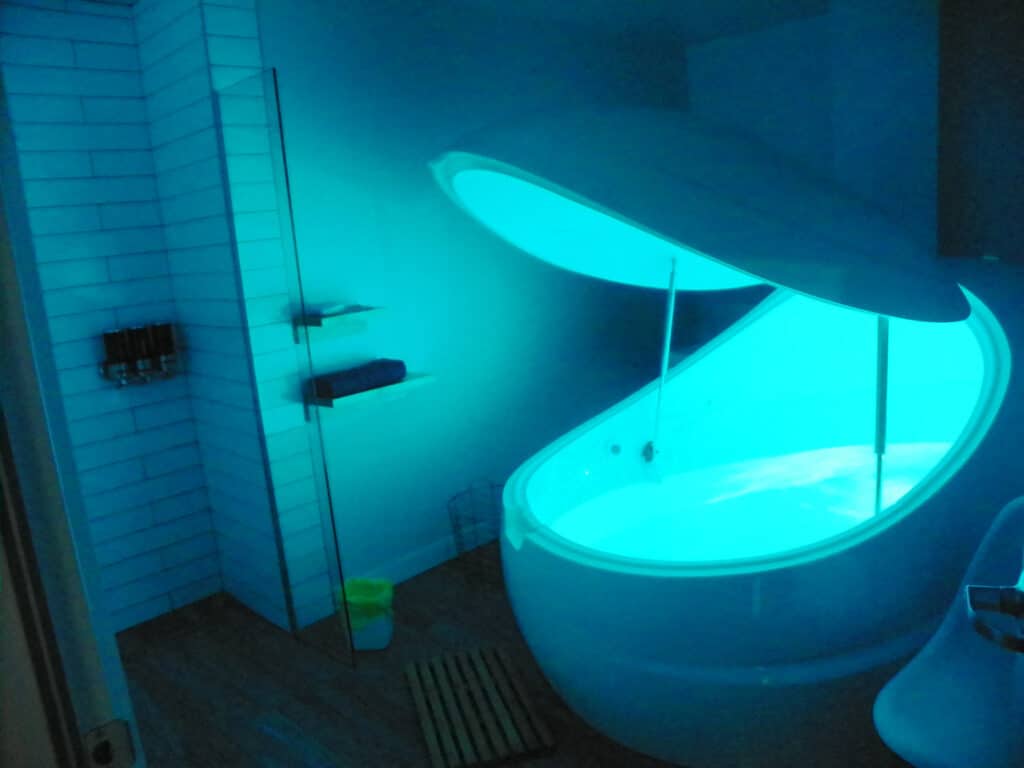Isolation Tanks: Benefits, Uses, and What to Expect
Isolation tanks, also called sensory deprivation tanks or float tanks, have become increasingly popular in wellness, sports recovery, and stress management due to their evidence-based positive effects.
By creating an environment free from external stimuli, isolation tanks allow the mind and body to enter a deep state of relaxation and restoration.
I’ve never personally used an isolation tank, so I don’t have direct experience with them.
However, research shows that float therapy can significantly reduce stress, anxiety, and muscle tension, making isolation tanks a promising tool for overall wellness (Feinstein et al., 2018; Jonsson & Kjellgren, 2016).
Whether you’re a professional athlete, someone dealing with chronic stress, or simply curious about the practice, learning about how isolation tanks work and their potential benefits can help you decide if they’re right for you!
What Is an Isolation Tank?

An isolation tank is a lightproof, soundproof chamber filled with about 10–12 inches of water mixed with a high concentration of Epsom salt (magnesium sulfate).
The dense saltwater makes it easy to float effortlessly, while the tank’s controlled environment blocks out light, sound, and external distractions.
Because of these features, isolation tanks are also commonly referred to as sensory deprivation tanks or float tanks.
What Is an Isolation Tank Like?

Floating in an isolation tank is often described as a weightless, meditative experience.
The water is heated to skin temperature (around 93.5°F or 34.5°C), so after a few minutes, you may lose awareness of where your body ends and the water begins.
Many people report feelings of deep calm, reduced stress, and even heightened creativity during or after a float session.
For some, the experience feels like meditation without effort, while others compare it to drifting in outer space.
What Is an Isolation Tank Used For?
Isolation tanks are used for a variety of physical and mental health purposes. Some of the most common uses for flotation tanks include:
- Stress reduction – Floating can lower cortisol levels, helping manage chronic stress and anxiety.
- Pain relief – The weightless environment may reduce muscle tension and joint strain, making it helpful for people with chronic pain or athletes recovering from training.
- Improved sleep quality – Research shows float therapy can improve both sleep duration and quality.
- Enhanced focus and creativity – By reducing external distractions, isolation tanks can promote clearer thinking and creative insights.
- Mindfulness and meditation – Floating offers an environment where the mind naturally shifts toward meditation-like brainwave states.
How Do Isolation Tanks Work?
Isolation tanks work by reducing sensory input to the brain.
Normally, your nervous system constantly processes signals from light, sound, touch, and gravity. In an isolation tank, those signals are dramatically minimized.
The absence of sensory input encourages the brain to shift into theta brainwave states, often linked with deep relaxation, meditation, and creativity.
Meanwhile, the buoyancy of the saltwater removes pressure from muscles and joints, allowing for faster recovery and relief from physical stress.
In short, isolation tanks provide both a mental reset and a physical reprieve from daily stressors.
Are Isolation Tanks Good for You?
Research suggests isolation tanks can provide meaningful benefits when used consistently.
Studies have linked float therapy to reductions in anxiety, depression, and pain, along with improvements in sleep, stress resilience, and overall well-being (Jonsson & Kjellgren, 2016; Feinstein et al., 2018).
For athletes, isolation tanks may enhance recovery by reducing inflammation and muscle soreness.
For others, the primary benefit may be improved mental clarity and reduced stress.
However, isolation tanks are not suitable for everyone.
People with certain medical conditions (such as severe skin wounds, epilepsy, or uncontrolled blood pressure) should consult a healthcare provider before trying float therapy.
Pregnant women may benefit from floating, but it is advisable to obtain medical clearance first.
Overall, when used safely, isolation tanks are considered a beneficial tool for physical recovery, stress reduction, and mental restoration.
Are Isolation Tanks Okay for People Who Are Claustrophobic?
People with claustrophobia often worry about whether they can tolerate being inside an isolation tank.
The good news is that most modern float tanks are designed with user comfort in mind, and they are spacious, well-ventilated, and you always have full control over the lid.
You can choose to float with the lid partially or fully open, and many centers offer larger float rooms instead of closed pods.
For some, floating may even help reduce anxiety over time by providing a safe, controlled space for relaxation.
Still, if claustrophobia is a serious concern, it’s best to speak with a professional and try a shorter introductory session first.
Final Thoughts: Should You Try an Isolation Tank?
As a natural remedy for stress relief, isolation tanks provide a unique way to calm the mind, relax the body, and promote overall well-being.
They combine the therapeutic benefits of buoyancy, sensory reduction, and magnesium absorption to create a unique environment for recovery and relaxation.
Whether you’re looking for better sleep, faster recovery from workouts, or simply a break from modern-day overstimulation, float therapy offers a natural, evidence-based solution.
If you’re curious, the best way to know if isolation tanks are good for you is to try a session and see how your body and mind respond.
This website does not provide medical advice. This website site does contain affiliate links, and purchases may earn a commission.
Read my Medical Disclaimer, Review Disclaimer, and Publishing Policies for more details. Use of this site indicates acceptance of these terms.



